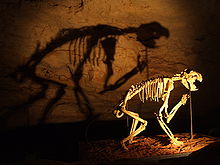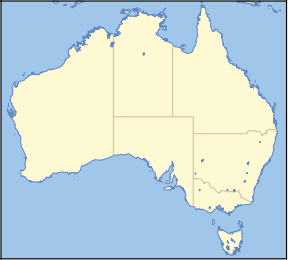- Naracoorte Caves National Park
-
Naracoorte Caves National Park Nearest town/city Naracoorte Coordinates 36°57′S 140°45′E / 36.95°S 140.75°E Area 3.05 km² Established 1994 Managing authorities Department for Environment and Heritage Official site Naracoorte Caves National Park Australian Fossil Mammal Sites (Riversleigh/Naracoorte) * UNESCO World Heritage SiteCountry Australia Type Natural Criteria viii, ix Reference 698 Region ** Asia-Pacific Inscription history Inscription 1994 (18th Session) * Name as inscribed on World Heritage List
** Region as classified by UNESCONaracoorte Caves is a national park near Naracoorte in the Limestone Coast tourism region in the south-east of South Australia (Australia). It was officially recognised in 1994 for its extensive fossil record when the site was inscribed on the World Heritage List, along with Riversleigh. The park preserves 6 km² of remnant vegetation, with 26 caves contained within the 3.05 km² World Heritage Area.
The park is a visitor destination in itself, with a camping ground and caravan park, dormitory accommodation for groups, picnic grounds and a licenced cafe. The range of visitor activities is extensive. Show cave tours are guided by professional interpreters through highly decorated caves with some tours visiting amazing fossil deposits. Modern technology has been utilised to show visitors the normally inaccessible interior of Bat Cave, where thousands of bats breed each year. Other opportunities include adventure caving, a selection of specialty tours and special events.
The limestone of the area was formed from coral and marine creatures 200 million years ago and again 20 million years ago when the land was below sea level. Ground water since then has dissolved and eroded some of the limestone, creating the caves. The caves, such as the Victoria Fossil Cave and Blanche Cave, are often not far below ground, and holes open up creating traps for the unwary. This is the source of the remarkable collection of fossils. Mammals and other land creatures have fallen into open caves and been unable to escape. The fossil record has been preserved in strata formed from eroded topsoil washed and blown in. In some places, the fossil-bearing silt is up to 20 metres thick. Some of these areas are being preserved for future research when better methods of dating and reconstructing fossil records may have been found. These fossil traps are especially significant for tracing Australian megafauna.
Contents
See also
References
- "Naracoorte Caves". ParksWeb: Wonambi Fossil Centre. Government of South Australia. 2006-09-05. Archived from the original on 2007-09-01. http://web.archive.org/web/20070901122002/http://www.parks.sa.gov.au/naracoorte/sitemap/index.htm. Retrieved 2008-02-22.
Further reading
- Achenbach, Joel (October 2010), "Lost Giants", National Geographic 218 (4): 90–109.
External links
- World heritage listing for Naracoorte
- UNESCO site with information on Riversleigh, Australia
- Naracoorte Lucindale Tourism
- Photographs of the Naracoorte Caves by Andrew McMillan
World Heritage Sites in Australia New South Wales Australian Convict Sites1 · Gondwana Rainforests of Australia1 · Blue Mountains · Lord Howe Island Group · Sydney Opera House · Willandra Lakes Region
Northern Territory Queensland Australian fossil mammal sites:1 Riversleigh · Fraser Island · Gondwana Rainforests of Australia1 · Great Barrier Reef · Wet Tropics of Queensland
South Australia Australian fossil mammal sites:1 Naracoorte
Tasmania Australian Convict Sites · Macquarie Island · Tasmanian Wilderness
Victoria Western Australia Australian Convict Sites1 · Ningaloo Coast · Purnululu National Park · Shark Bay
External territories (Norfolk Island) Australian Convict Sites · Heard Island and McDonald Islands
1 Shared with other states/territories Protected areas of South Australia National Parks Belair · Canunda · Coffin Bay · Coongie Lakes · Coorong · Flinders Chase · Flinders Ranges · Gawler Ranges · Innes · Lake Eyre · Lake Gairdner · Lake Torrens · Lincoln · Mount Remarkable · Murray River · Naracoorte Caves · Nullarbor · Onkaparinga River · Vulkathunha-Gammon Ranges · Witjira
Conservation Parks Acraman Creek · Billiatt · Black Hill · Cape Gantheaume · Cleland · Cox Scrub · Danggali · Deep Creek · Fairview · Finniss · Fort Glanville · Gum Laqoon · Kelly Hill · Hacks Lagoon · Hallett Cove · Horsnell Gully · Kaiserstuhl · Lake Gilles · Mamungari · Marino · Monarto · Morialta · Mount Magnificent · Naracoorte Caves · Ngarkat · Peebinga · Piccaninnie Ponds · Scott Creek · Seal Bay · Simpson Desert · Spring Gully · Talisker
Recreation Parks Regional Reserves Innamincka · Lake Frome · Nullarbor · Simpson Desert · Strzelecki
Conservation Reserves Chadinga · Naracoorte Caves
Wilderness Protection Areas Game Reserves Categories:- IUCN Category II
- World Heritage Sites in Australia
- National parks of South Australia
- Caves of Australia
- Limestone caves
- Show caves
- Australian Aboriginal placenames
- Protected areas established in 1994
- Australian National Heritage List
- Pleistocene paleontological sites of Australia
- 1994 establishments in Australia
- Limestone Coast
Wikimedia Foundation. 2010.



